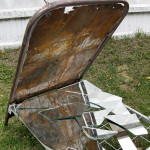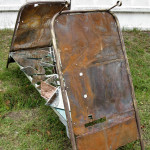DORMITORY DISTRICT, installation. Special project by Moscow Museum of Contemporary Art for the III Moscow Biennale of Contemporary Art, 2009
In case if the declared theme of the Moscow Biennale is so democratically general, ‘without exception’, it means that the unrestrained range must include the sphere of living in a specific formation, called a ‘dormitory district’ in the Russian megalopolis. It is easy to arrange art interventions in the museum halls, breaking academic immobility, or to ask gallery owners to pull apart the sterile walls of the white cube, willing to go out. But could you play music on the unsuitable iron bed rails in front of the fence near the Volzhskaya metro station?
It is the social constituent that is most important in the ‘Dormitory District’ project by the artists Marina Zvyagintseva, Sergei Denisov and Ivan Kolesnikov, who are not only co-authors but also curators and organizers. They invite their fellow artists to go out in a definite unpleasant street with a concrete wall as a main decoration. The above beds, transformed into artifacts, will appear as local phantasms on the fence and in front of it. There is a temptation to interpret artworks of about 70 project partakers as a literal materialization of dreams of the residents of the Krasnodonskaya street and its neighborhood. But the majority of the authors have never been in the place, and the ‘dormitory district’ notion is just ephemeral for them. The ideas how to use the utilitarian beds have been born on paper rather than in dreams.
It seems that the very wire beds, the dull rough grey fence and the landscape of the dormitory district that looks like accurately drawn along the ruler, suggest an ideal space for the author’s utterance that is called ‘tabula rasa’. The artists elaborately create their texts on the clear whiteboard of another’s dream, the texts that turn into palimpsests. The energy of the location has an impact.
The known Zhulebino resident Marina Zvyagintseva who has opened a gallery of contemporary art there, is famed for her call upon the ‘genius loci’. It has provoked the idea of the urbanistic project ‘Dormitory District’ that aims at carrying arts to the people and developing street spaces of a different locus, though in the outskirts. The leitmotif (or rather an object, a home task for the participants, from beginners to celebrities) is a bed as a topographic sign. The bed, merged with the fence, has defined the semiosis of the location with the symbolic name ‘dormitory district’.
The Russian culture has the “St. Petersburg text” (thanks to V. Toporov). Now the “Uptown text” has appeared, written with pleasure, together, in the open air. It is planned to be read by a wide audience. To do this, it has to go from the bed to the fence. Otherwise the social constituent of the project will reach the educated guests of the Moscow Biennale of Modern Art only.
 |
 |
 |
 |
